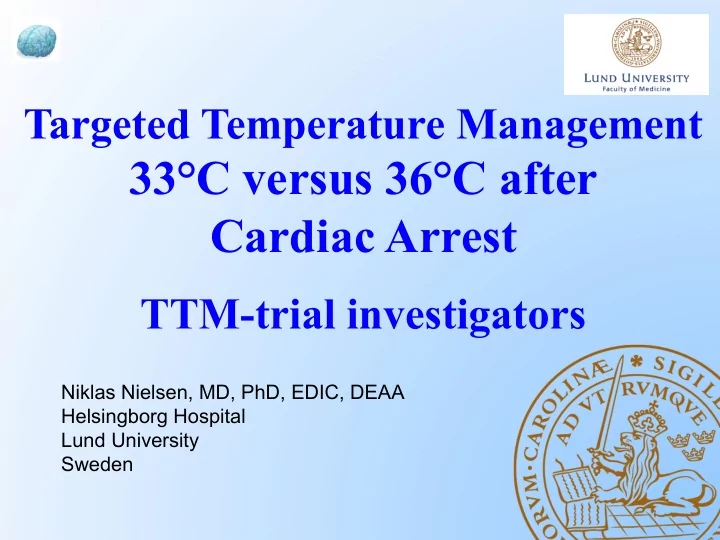

Targeted Temperature Management 33°C versus 36°C after Cardiac Arrest TTM-trial investigators Niklas Nielsen, MD, PhD, EDIC, DEAA Helsingborg Hospital Lund University Sweden
• Hypothermia to 32-34°C after out-of- hospital cardiac arrest is recommended in guidelines • The overall quality of evidence for temperature management is low according to GRADE • The optimal target temperature has not yet been determined Nielsen et al. Int J Card 2010
M ain objective • To assess the benefits and harms of a targeted temperature management at 33°C versus 36°C • Avoiding fever in post-cardiac arrest patients in both groups
TTM-trial – 2010-2013 • 950 patients randomized • 36 hospitals • 10 countries • Europe and Australia Funded by: Swedish Heart Lung Foundation AFA-insurance Foundation, Sweden Swedish Research Council Governmental and Regional funding within the Swedish National Health System TrygFoundation, Denmark Zoega, Krapperup, Thure Carlsson, Trolle-Wachtmeister foundations, Sweden
Design and timeline • Temperature intervention 36 hours • All patients sedated and ventilated minimum 36 hours • Feed-back controlled cooling devices in all patients • Intravascular or surface devices Inclusion 240 min Prognostication Half year follow up 36 h 72 hours 180 days 956 d ROSC Intervention ICU, hospital discharge
Methodological design • 20% Hazard ratio reduction • 5% α , 90% predicted power • Standardized rules for prognostication • Standardized rules for withdrawal of life support • Blinded prognostication • Blinded outcome assessment • External monitoring
Inclusion criteria • Out-of-hospital cardiac arrest • Adult (18 years and over) • Presumed cardiac cause • All initial rhythms • Unconscious (Glasgow Coma Scale < 8) • Stable Return of Spontaneous Circulation
Main exclusion criteria • Unwitnessed arrest with initial rhythm asystole • >240 minutes from Return of Circulation • Body temperature below 30°C • Known or suspected intracranial hemorrhage and stroke
Outcomes • Primary outcome: Survival • Secondary outcomes: Mortality and poor neurological function at 180 days ü Cerebral Performance Category ü Modified Rankin Scale Serious adverse events
Baseline characteristics 33°C 36°C No. 473 466 Age 64+/-12 64+/-13 Male sex 83 % 79 % Arrest in place of residence 52 % 55 % Arrest in public place 42 % 40 % Bystander witnessed 89 % 90 % Bystander CPR 73 % 73 % Shockable rhythm 79 % 81 % Arrest to ROSC (min) 25 [18-40] 25 [16-40] Circulatory shock on adm. 15 % 14 % Lactate mmol/L 6.7±4.5 6.7±4.5 ST-elevation infarction 40 % 42 % GCS 3 [3-4] 3 [3-4]
Temperature profile Mean ± 2SD 39 °Celcius P<0.0001 38 37 36 35 TTM36 TTM33 34 33 32 31 Hours 30 0 1 2 3 4 5 6 7 8 9 10 11 12 13 14 15 16 17 18 19 20 21 22 23 24 25 26 27 28 29 30 31 32 33 34 35 36
Survival P=0.51 No difference in survival
Outcomes Outcome TTM33 TTM36 HR or RR (95% CI) P Value PRIMARY OUTCOME 100% follow-up Mortality at the end of trial Dead no./total no. (%) 235/473 (50) 225/466 ( 48) HR=1.06 (0.89-1.28) 0.51 SECONDARY OUTCOMES 99% follow-up Neurological function at follow-up CPC 3-5–no./total no. (%) 252/469 (54) 242/464 (52) RR=1.02 (0.88-1.16) 0.78 mRS 4-6–no./total no. (%) 245/469 (52) 239/464 (52) RR=1.01 (0.89-1.14) 0.87 Serious adverse events Any event–no./total no. (%) 439/472 (93) 417/464 (90) RR=1.03 (1.00-1.08) 0.09
Subgroups Results consistent in pre-defined subgroups
Conclusion In unconscious survivors of out-of-hospital cardiac arrest of presumed cardiac cause targeting a temperature of 33°C did not confer any benefit compared to targeting a temperature of 36°C
Recommend
More recommend